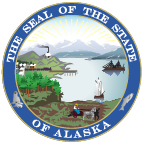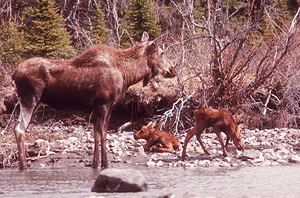The following is a greeting given in one of the 20 indigenous languages recognized by the State of Alaska.
- Ade’ ndadz dengit’a?
- Language: Deg Xinag
- Translation: "Hello, how are you?"
Wildlife Viewing
Wildlife Viewing
Bald eagles live across most of Alaska, with the greatest concentrations found in the Southeast region. On the Chilkat River near Haines, as many as 3,500 bald eagles gather each winter to feed on late-spawning chum salmon, (the river stays unfrozen for much of the winter due to warm water upwellings). Admiralty Island is home to the densest nesting population of bald eagles known in the world. Eagles, however, can be spotted everywhere in Southeast Alaska, (and much of the rest of Alaska), sitting in the conifers and cottonwoods and gazing at the water and at passing tourists. The Inside Passage is also a good area to look for land animals like mountain goats, porcupines, Sitka blacktailed deer and hoary marmots. Abundant salmon runs support large populations of black and brown bears which are often seen scavenging along the beaches, congregating around the mouths of salmon streams, or feeding in the forest and apline areas. This is also one of the best marine mammal viewing areas of the state. In the vast Interior, great herds of caribou roam the tundra and countless migratory birds nest during the summer months. Brown bears feed on young herbivores, roots, and berries and Dall sheep inhabit the mountain ranges. Other interior land animals include wolves, red fox, moose, musk ox, owls, hawks, countless rodents, and a large variety of other animals. Though better known for its marine life, Southcentral Alaska is also a good region for spotting Dall sheep, moose, bear and migratory birds. The Kenai Peninsula provides excellent opportunities for brown and black bear viewing where they congregate to feed along salmon streams. The local trout make this area an international fishing destination in season. Southwest Alaska shares many wildlife characteristics with the interior. The Yukon Delta National Wildlife Refuge is the largest wildlife refuge in the country and is seasonally home to 750,000 swans and geese, two million ducks, 100 million shorebirds, as well as wolves, caribou, and black and brown bears. Kodiak Island in the Gulf of Alaska is home to the world's largest carnivore, the Kodiak brown bear, a subspecies of brown/grizzly bears, (which are considered the same species). (Despite this designation, a considerable amount of a brown bear's diet consists of vegetation, roots, and berries). The string of Aleutian Islands separating the North Pacific Ocean from the Bering Sea is another haven for seabirds. Millions of migratory and resident birds nest there, including fulmars, auklets, and the largest colony of tufted puffins in Alaska. A number of primarily Asian species also make appearances in the Aleutians. These islands are home to the sea otters that first drew Russian fur traders to Alaska. To the north, the Pribilof Islands attract about a million fur seals each summer, making it the world's largest pinniped congregation in the world. Seabirds also abound on these islands. The North Slope of Alaska, (the northern edge), is considered one of the largest waterfowl nesting areas on earth. Tundra swans and loons are most easily spotted May-August and rarer birds like eiders are found as well. This is also the best region to see massive caribou herds and, if you're extremely lucky, you may spot a polar bear on the ice pack off the northern coast or around some of the northern villages. Near Nome, moose, reindeer, bear, and musk oxen are frequently seen from the 300+ mile road system. This is also Arctic fox territory. Coastal Waters around Alaska offer excellent opportunities to see marine life including whales, dolphins, porpoise, seals, sea lions, fur seals, walrus, sea otters, and seabirds. Private coastal tours are concentrated in the Southeast communities of the Inside Passage and Southcentral's Prince William Sound and Kenai Peninsula region. Southwest Alaska, while less popular as a tourist destination, is famous for its walrus, seabird, and fur seal populations. Many species of cetaceans have been spotted off Alaska's shores; whale species include humpbacks, sei, blue, fin, gray, bowhead, minke and several species of beaked whales. Dall's and harbor porpoise are common, as are several dolphins and close dolphin relatives including belugas, orcas, (killer whales), Pacific whitesided dolphins, and narwhals, (whose single tusk is the origin of spiral medieval unicorn horns), in various parts of the state. Seabirds are plentiful virtually everywhere on the waters around Alaska, particularly during spring and fall migrations. Click on the following titles for more detailed information.
|
Alaska Facts
State Nick Name: "The Last Frontier" - the name Alaska is derived from the Aleut word "Alyeska," meaning "great land."
State Motto: "North to the Future"
State Capital: Juneau, located in the Southeast region of Alaska, has a population of 33,277 (2015 Estimate of Population, Alaska Department of Labor and Workforce Development)
Alaska Map:

Alaska Flag:

NOTE: The State of Alaska is not responsible for the content/information on any site outside of a State of Alaska department.

